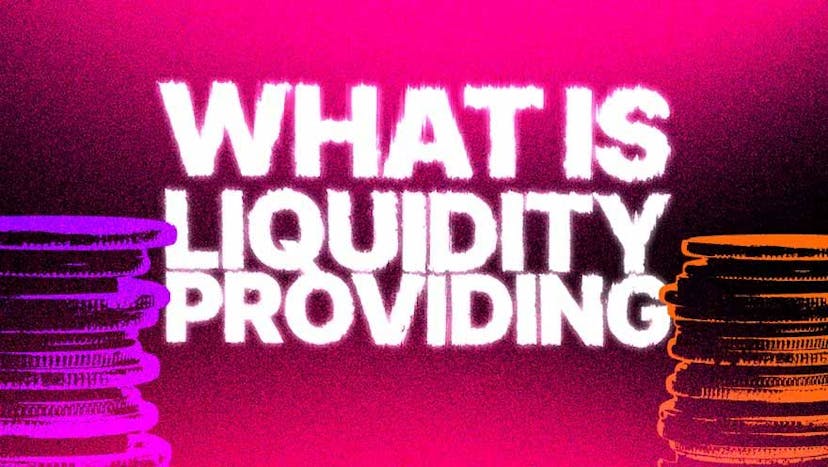What Is Liquidity Providing?
A Step-by-Step Guide to One of the Most Used Practices in DeFi
By: Rahul Nambiampurath • Loading...
Tutorials
Anyone who has participated in the real estate market understands the value of liquidity. The longer it takes to match a buyer with a seller and finalize that transaction, the lower the housing market’s liquidity. Because homes are inherently scarce due to land size limits and building materials involved, they are inherently illiquid assets.
By the time it takes to convert real estate into cash, a price change is unavoidable. Yet, even assets that are not inherently illiquid reside on a liquidity spectrum. If there are not enough dollars to convert into euros, the foreign exchange market for that particular trading pair has low liquidity.
In that situation, the lopsided demand for dollars raises its value. Over time, various institutions have been created to increase the market’s liquidity. This begs the question, how can liquidity be maintained in a decentralized market based on blockchain’s smart contracts?
What Is the Master Liquidity Provider?
Using the real estate example, it is clear that homes are non-fungible assets, which makes them inherently illiquid. That’s because each home is unique for the simple reason it occupies a unique space in the space-time continuum. Therefore, each real estate unit has different characteristics that add or subtract its value.
As such, they cannot be easily exchanged for another asset. In contrast, fungible assets can. These are currencies, cryptocurrencies, commodities, stocks, and derivatives. Although their value is derived differently, it is uniformly exchangeable because their characteristics are flat. In other words, one stock share or one dollar is no different from the other units of the same kind.
What Is Yield Farming?
The value of fungible assets is then derived by their quantity and availability. Case in point, in August 2020, Tesla (TSLA) split its stock by five. What was the effect of that?
- Tesla made its shares available to a larger investment pool by lowering the cost of each share by 80%. Existing shareholders held the same stock value, but distributed across a greater number of shares.
- The company’s market capitalization remains the same.
- Because there is a far greater number of shares present, the company’s liquidity increases because it is easier to trade lower-priced stock shares.
By the same token, when a central bank such as the Federal Reserve increases the money supply, it increases liquidity. The Fed can increase or decrease interest rates. With a $1T injection, the commercial banking sector can convert illiquid securities into liquid deposits.
This itself raises the price of these securities because it lowers their supply. In turn, lowered supply of securities increases their demand, causing interest rates to fall. With such a liquidity tool, central banks influence the direction of the nation’s entire economy.
This places central banks as the top market makers of any nation. Of course, one of the side effects of increased liquidity on such a macro-level is the increase in inflation.
As of June 2022, the inflation rate reached a 40-year high of 9.1% because the Fed infused trillions of dollars into the economy to stave off the equity market crash during the 2020 COVID-19 event.
Just like the greater number of stock shares makes each share less valuable, so does the greater number of dollars make each dollar less valuable. In 2022, one could buy 9% less with dollars that one could’ve bought a year ago for the same dollar amount.
Who Is the Commercial/Retail Liquidity Provider?
At the layer beneath central banks, commercial banks and other financial institutions play the role of market makers to ensure liquidity for various markets. What does that mean exactly?
Let’s say Andrew wants to buy one TSLA stock share using a brokerage app like Robinhood. Andrew saw a market opportunity, so he entered the market when TSLA shares were at a specific price. Therefore, he expects that he will buy that share at that price at which he entered the market.
On the other side of the trading equation, there is Jack, who wants to exit the market by selling his TSLA stock share at a specific price. As a broker, Robinhood matches Andrew’s buying price (bid) with Jack’s selling price (ask). However, Robinhood is just an intermediary to make it happen.
Instead, Robinhood relays that trading order to a market maker like Citadel Securities. This financial institution covers traders’ asks and bids, so there is always an available match between them. In other words, market makers provide market liquidity by covering the spreads between asks and bids.
Clearing houses step in as the last step in that process by settling trades. At the basic level, this makes a simple stock trade go through three intermediaries:
- Brokers
- Market Makers
- Clearing Houses
In the case of Robinhood and Citadel Securities, the arrangement is called pay-for-order-flow (PFOF). Meaning, as Robinhood directs its trade orders to Citadel Securities, it receives compensation. In turn, Citadel Securities receives compensation as a market maker by ensuring that those ask/bid trades are matched in a timely manner. While these cuts are tiny, they happen over enormous trading volumes.
Trading volume significantly ramped up in 2020 as a result of COVID-19 lockdowns, marking a new era in retail stock trading. Source: NYSE Market Maker Whitepaper
The measure of this asset tradability is known as the depth of market (DoM). It is simply a representation of all outstanding sell and buy orders contrasted against each other and composed within an order book. If both sides of the buy and sell walls are high, this means there is a significant number of available orders that can be fulfilled. This translates to high market liquidity.
Visualized order book shows the bid (green) and ask (red) walls. Assets with strong DoM typically show nearly equal walls in height, indicating high liquidity. This is especially true of assets with large market capitalization, such as Bitcoin (BTC). Source: Coinglass.com
Just as market makers like Citadel Securities provide liquidity for stocks, so do centralized cryptocurrency exchanges like Binance (via Sigma Chain AG and Merit Peak Ltd) provide liquidity for cryptocurrencies. Without such market makers, asks and bids would be in a holding pattern until Andrew’s buy order matches Jack’s sell order. Needless to say, such a market would have very low liquidity.
Case in point, not all cryptocurrency exchanges have market makers. Because of this, it takes much longer to fulfill an order on exchanges like Gate.io than on Binance/Coinbase, where trades are nearly instantaneous. For this reason, Gate.io has an open market maker application policy. That is, if one meets a minimum requirement of $120 million monthly trading volume.
Who Provides Liquidity Without Market Makers?
So far, we have learned:
- The importance of market liquidity
- How central banks use money market liquidity to steer the economy.
- How commercial market makers facilitate trades on equity and crypto markets.
While traditional market makers are electronic, market makers like Binance/Coinbase/Gate.io have an additional layer to take into account — blockchain. As a distributed record of all transactions that are time-stamped in a chronological order, transactions on a blockchain create an immutable chain.
Meaning, if a single record is tempered with, a new chain would be created from that record — hard fork. However, it doesn’t matter how many forks are created, as long as the blockchain’s miners/validators dismiss them. This is the elegant security of blockchain assets, as it would take 51% of miners/validators to compromise the network.
In the case of Bitcoin, such a scenario would be virtually impossible, given the amount of CPU power required to overtake the blockchain. Specifically, over 200 TWh worth of energy in computing power, which is more than the country of Poland or Thailand.
Source: BitcoinEnergyConsumption.com
Although Bitcoin taps into 76% renewable energy for its needs, that is the price of security in a proof-of-work (PoW) blockchain network. On the other hand, proof-of-stake (PoS) blockchains have minuscule energy requirements, as each transaction is validated by economic staking instead of computing power.
Typically, PoS networks are also smart contract platforms, making it possible to create a new type of market maker — Automated Market Maker (AMM).
How Do Smart Contract Blockchains Provide Liquidity?
Ethereum (ETH), Cardano (ADA), Solana (SOL), Avalanche (AVAX), Algorand (ALGO), Fantom (FTM), and Terra (LUNA) are all PoS smart contract platforms that create a new breed of finance — Decentralized Finance (DeFi).
Technically, Bitcoin (BTC) is also a smart contract platform, but it is a single-minded one, generating and maintaining deflationary sound money. In contrast, the aforementioned PoS networks are far more flexible in their smart contract deployment. They range from lending, borrowing, and gaming to NFTs and insurance coverage.
Ethereum alone provides nearly 3,000 dApps. Source:
In other words, they recreate all the existing financial services without banks, market makers, clearing houses, and brokers. Smart contracts supplant them all by directly linking traders in an automated and decentralized manner.
In simple terms, a computer code stored within a blockchain’s data block executes agreements that would otherwise be executed by banking clerks. These agreements execute when conditions are met, including providing decentralized liquidity.
To illustrate, Uniswap is a decentralized exchange, allowing investors to swap tokens, just as one would swap currencies in a forex market or a bank. Uniswap is also a dApp (decentralized application), which is just an interface that bridges the user to the blockchain’s smart contract. In particular, Uniswap’s smart contracts are liquidity pools. They contain token trading pairs provided by other traders.
One of the most common trading pairs is a stablecoin vs. a crypto asset — for instance, USD Coin (USDC) vs. Ethereum (ETH).
Without a central body to cover the spread for USDC/ETH conversion, traders themselves provide liquidity. They do so by selecting a liquidity pool of a particular trading pair and lock up their assets into it. Then, whenever other traders use Uniswap, they tap into that pool, giving liquidity providers (LPs) a cut for their decentralized service.
The protocol by which this process is conducted is called Automated Market Maker (AMM). There are no requirements in becoming a liquidity provider (LP) except the funds themselves. Quickly and directly, anyone with a MetaMask wallet can connect it to Uniswap dApp, which connects to Ethereum’s smart contracts.
Exactly the same process and incentive structure applies to lending and borrowing services as well. Such dApps like Aave or Compound have liquidity pools from which investors can either lend (lock in assets) or borrow (tap into liquidity pools). In both cases, liquidity providers are also called liquidity miners or yield farmers.
Is Decentralized Liquidity Mining Safe?
DeFi creates a brand new financial dynamic by directly linking traders and liquidity providers by directly linking traders and liquidity providers. First of all, borrowers can pay their debt at any time. This alone translates into a popular investing strategy of leveraged longs and short selling. In other words, borrowing stablecoins to buy more volatile crypto assets or borrowing risky crypto assets to buy them later.
For this reason, the collateral on DeFi platforms commonly consists of volatile assets (up to 75%), while the borrowing consists of stablecoins (up to 90%).
Source: IMF: Global Financial Stability Report (April 2022)
Needless to say, due to crypto volatility, this then leads to big liquidation events when market downturns happen, which is exactly what happened during the crypto crash in May 2021.
Source: IMF: Global Financial Stability Report (April 2022)
Aside from liquidations triggered by the inherent volatility of crypto assets, there is also the problem of cyberattacks. They have ramped up drastically since 2020, when the DeFi market started to take off into the mainstream.
Source: IMF: Global Financial Stability Report (April 2022)
One of the most recent such examples is the North Korean Lazarus group hacking Axie Infinity for $625 million. In such instances, it is often the case that the platform loses reputation and collapses, as LPs withdraw their assets and remove market liquidity with them.
Even without a hack, whale action could exert the same effect. This is exactly what happened with billionaire Mark Cuban and Iron Finance. Because Iron Finance uses an algorithmic stablecoin, it only took some whales to remove liquidity from IRON/USDC, sell TITAN to IRON and convert IRON to USDC without redeeming IRON tokens, causing the algorithmic stablecoin to de-peg.
What Is Staking?
Lastly, providing liquidity is risky in that it can cause impermanent loss. Again because of crypto volatility, a scenario can happen when the token’s price is different from the one when it was locked into a liquidity pool. Regardless if it is higher or lower, the greater the price discrepancy, the greater the impermanent loss (IL).
In practical terms, if IL surpasses LP fees, liquidity providing yields a loss instead of a gain. Of course, IL can be completely avoided if LP picks stablecoin vs. stablecoin liquidity pool. In that case, the peg to the dollar of both tokens ensures there is no significant price shift.
Advertisement
Get the best of The Defiant directly in your inbox 💌
Know what matters in Web3 with The Defiant Daily newsletter, every weekday
90k+ investors informed every day. Unsubscribe anytime.

